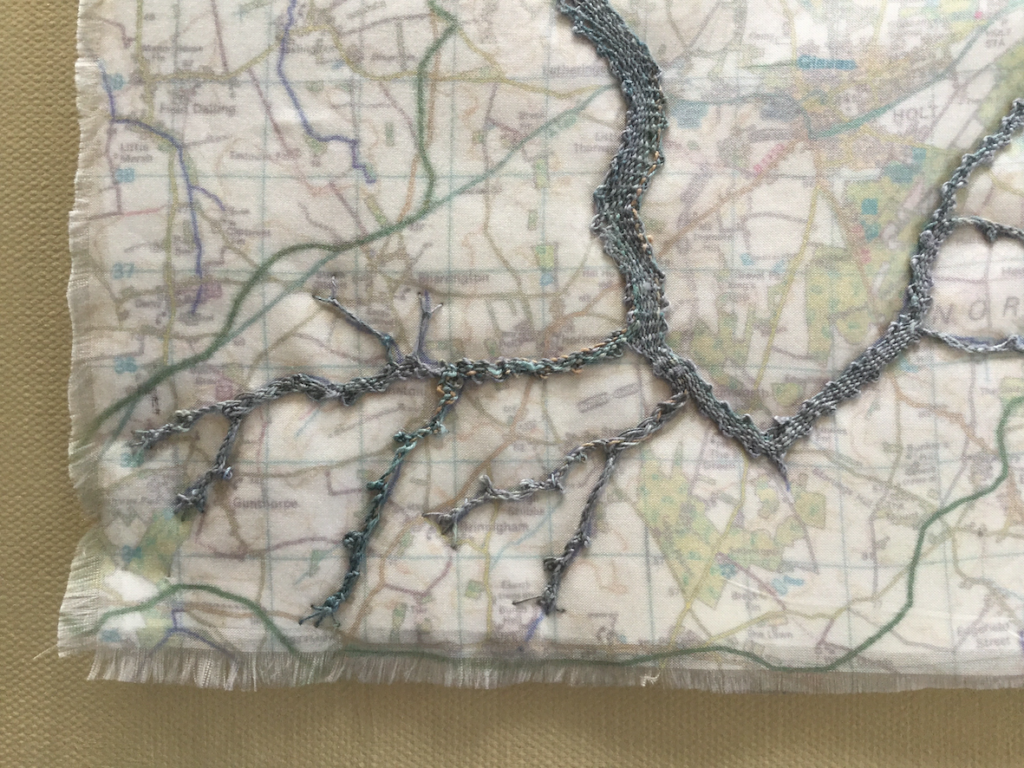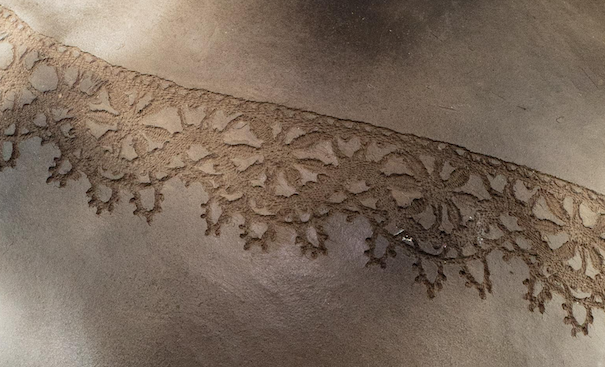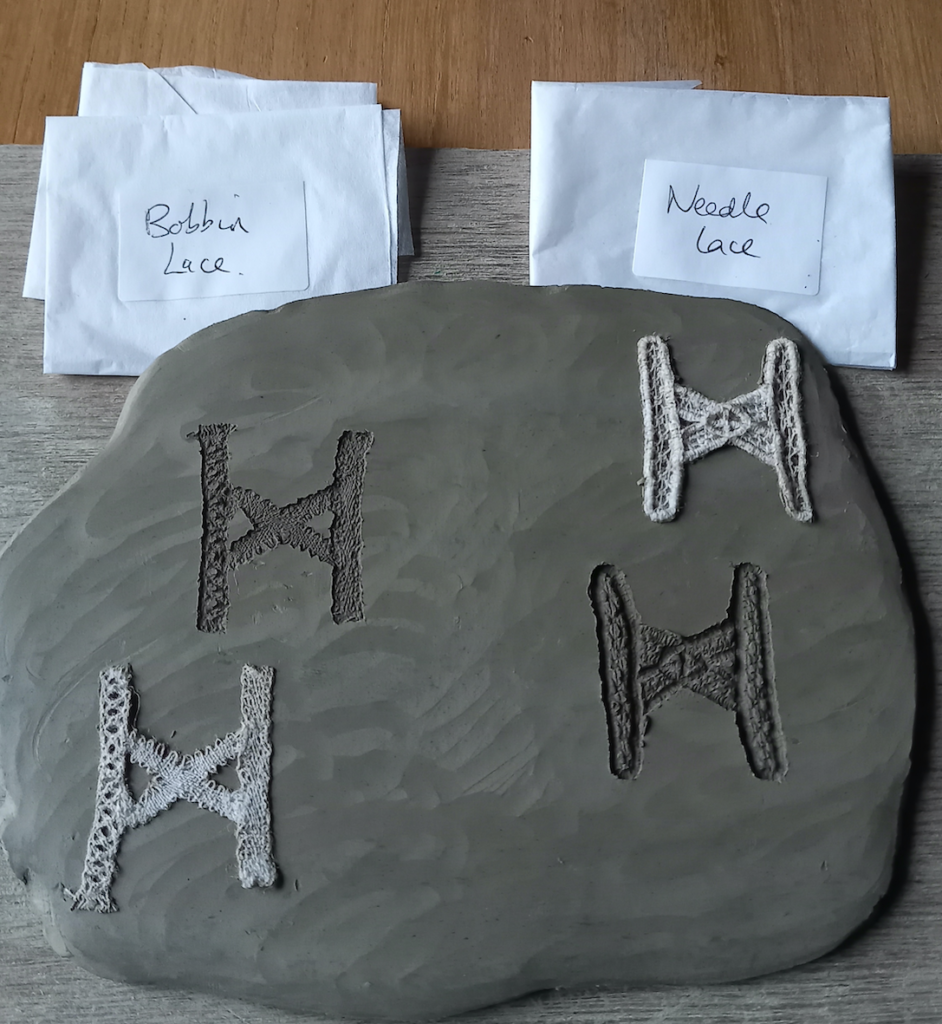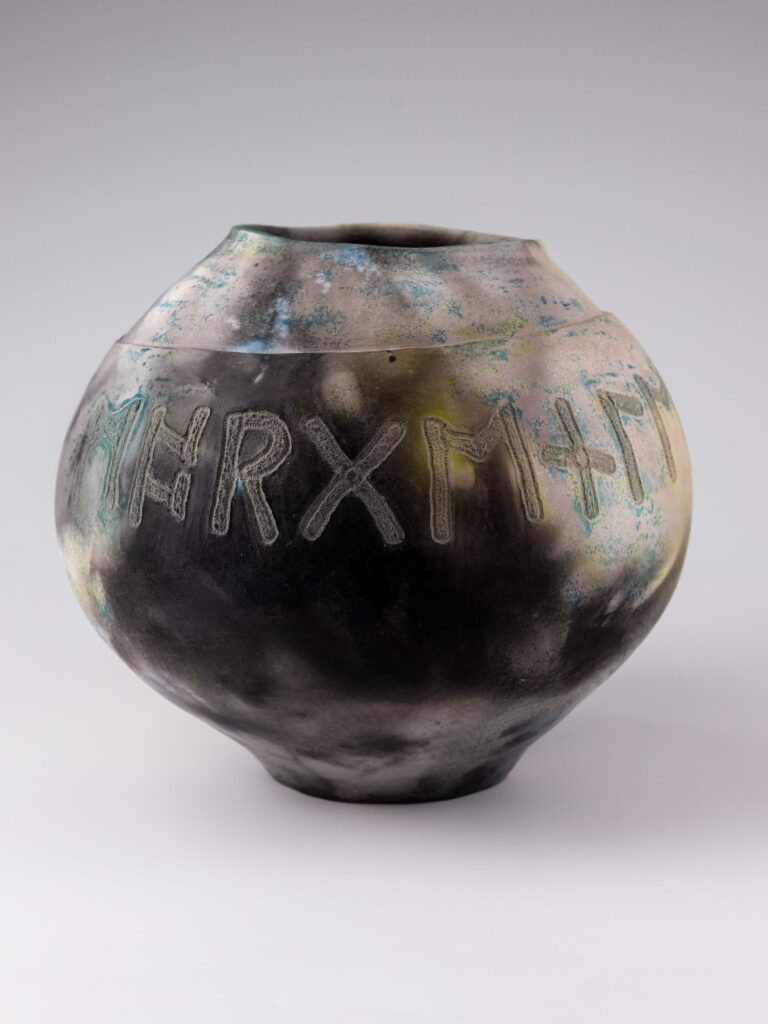Lace Vessels – collaborative working
Because of its semi-transparent nature, lace is always seen in the context of something else, whether another textile, wood or, of course, skin. Over centuries, its designs, repeats and fillings have been used by many other skilled designers and practitioners in their own work: for example, in early St Cloud soft paste porcelain, in architecture, in picture frames or in marquetry. Why this is so could be the subject of an entirely different article!
Kate Vogler describes her pieces as ceramic sculptural vessels, often smoke-fired, built from coiled clay. Her work is meticulous and beautiful. I have known Kate for many years and, during one of our wide-ranging discussions, we decided to work together to combine lace with clay. For both of us it was a venture into the unknown even though we knew that it was not historically a new idea but one that we would like to revisit. But how to start and then how to proceed? We wanted to enhance a sense of working lace and clay that has gone before, heritage in the widest sense, while developing new, exciting pieces.
We soon recognised that many of the attributes needed for such a collaboration were complementary: working with the hands, the use of pliable yet fragile material, concerns with scale, texture, colour or lack of colour. It was unusual for both of us of to be working in collaboration rather than ‘solo’, so trust and confidence in each other was also important. We share interests in words, music and rhythm, time and history, our immediate and the wider landscape and their care, and these themes have been developed through our joint work.
Our first experiment used an existing piece of needlelace and a slab of clay, with the lace being simply pushed into the wet clay on a horizontal surface. When we removed the lace, we were both delighted enough with the result to continue experimenting. Next, we used a length of bobbin lace made in linen, again pressed into a slab (Fig. 1).

Fig. 1
This slab was then worked onto a pot by Kate, who knew through vast experience when the clay was at the right stage of ‘dampness’ for the process (Fig. 2). The depth that we pressed it in worried me, but Kate’s confidence was rewarded when we again ‘released’ the lace cleanly.

Fig. 2
After much work by Kate, smoothing and finishing, the pot was biscuit-fired; colouring was added and then the pot was fumed in a kiln (Fig. 3).

Fig. 3 Ophelia’s pot, 2018, approx. 45 cm high
The accuracy of the imprint of the lace amazed us both. I think that this is when we became much more aware of how the way lace works on the human body was echoed in the way in which Kate had placed the lace around the shape of the vessel.
We were working together for an exhibition named ‘Confluence’ and our next piece reflected a more conventional interpretation of the theme. It also demonstrates an increasing confidence in the combination of our skills. Using an old local map and linen, I worked two versions of the path of the River Glaven, a rare chalk river in north Norfolk close to where we both live. The first was impressed into a vessel made by Kate who, in turn, had worked the ‘neck’ of the vessel following my pattern (Fig. 4). She had now decided on the more difficult method of pressing the lace into the actual clay of the pot rather than using a slab – how she did this without disturbing the form of the vessel remains amazing! Her technique evolved to brushing slip all over the pot, then burnishing it before removing the lace. This leaves the lace marks crisp and untouched.

Fig. 4 The River Glaven
The accompanying version was again worked in linen, this time using colour, and mounted on silk with the map transferred onto it (Fig. 5).

Fig. 5 Detail of lace version of The River Glaven
Working to a commission provides different challenges. We were asked to make a vessel by my son and his partner, and they had specific ideas about the lace and the smoked, neutral colourway and finish of the vessel. One weekend, I provided them with every lace book I had so that they could choose the style of lace before I designed it. I was quite surprised that they chose something traditional but worked with Bedfordshire elements to design a pattern that subtly developed over the repeats (there is a secret message which I will only divulge to them if certain things come to pass!) From the image, you can see the detail of the threads that is maintained throughout the process (Fig. 6).

Fig. 6 Detail of the lace imprint on the ‘shoulder’ of Guy and Charlotte.
At this point, I should add that the linen threads that I used to make the lace for the vessels were resilient to all the handling they had endured: being pressed into the clay, being gently removed days later and then the slip washed off. I did not pin the lace out after washing and every piece could be reused if necessary. My lace is precious to me, and I was surprised by how tough and patient it was. This reminded me of all the laundering of lace through the centuries which was so important in its use (another article!).
Our latest collaboration is different again and reverts to our shared interests in words and history. We have made a series of five vessels inspired by words from the earliest written works in English which I then ‘translated’ into runic form. I made the ‘runes’ in needlelace after experimenting with bobbin lace, again in fine linen thread (Fig. 7). Crucially, I remembered to make them in reverse so that the cordonnette was impressed into the clay. I used stitches that were reminiscent of the patterns carved in Scandinavian rune stones.

Fig. 7 Experimenting with ‘runes’, 4 cm high
Kate ‘grew’ the vessels and very subtly coloured them to echo the chosen words (Fig. 8).

Fig. 8 Morgenleoht (Dawn), 2021, approx. 18 cm high. Photo credit: Ó Marcin Roszko
Our work has to do with a love of evolving language, ancient carved stones and the enduring shapes of vessels as we attempt to seamlessly combine our interests and skills.
Through working together, we have enjoyed discussion of issues arising, laughter, sympathy, and serendipity. We have discovered what is successful and improved our methods with increasing confidence. What is, perhaps, most exciting is that we both have plenty of ideas for continuing our collaboration!